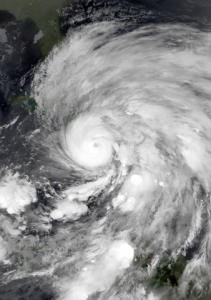When the Air Quality Matters blog first was started – Nov. 5, 2012, President Barack Obama had just completed his very first term in office and was ready to embark on his second. Meanwhile, the country at this juncture had emerged – and I would add glowingly and stalwartly – from what has since become known as the Great Recession.

But 2012, like the prior four years, was not without ills of its own; namely, and mainly, in the form of Hurricane Sandy, which ravaged communities/property in New York and New Jersey especially, where those/that on the ocean front were/was particularly hard hit.
Further troubling, even though there resumed manufacturing activity which was by that time much stronger than what it had been, lower numbers in the ranks of the unemployed, and a much-improved housing market, signified by an increase in traffic occupying the nation’s thoroughfares, and highly indicative of economic-better times having arrived, air, subsequent to it having gotten a bit of a breather; in other words, the atmosphere was provided the opportunity to recover some, once more took a turn for the worse, and from transportation in particular as it was – and still is – the lone sector among all others where emissions are on the rise instead of the other way around.
That said, California – a state, no less, through passage in 2006 of California Assembly Bill 32 (the Global Warming Solutions Act) and in 2008 of state Senate Bill 375 (the Sustainable Communities and Climate Protection Act) as well as other similar legislative initiatives becoming law has demonstrated to the nation and world that by being green, and having manufacturing and services reflecting that principled tack, it just goes to show the state economy does not have to suffer because of that. In fact, what has taken place is the opposite.
Understanding this and this being at the doorstep of 2017, where are we exactly in terms of getting transportation emissions under control, in check and ultimately when it comes to their reversing course? This, while ensuring that the same if not improved levels of motive-power performance are maintained and done without causing an undue burden on owner/operator budgets. This gets off into a whole different discussion and is a conversation for another time, but the point is, it can become reality as long as the will to do so is there.
All of which brings us up to where we are today. And, where it is we wish to go moving forward, once that’s decided, how it is we wish – what course do we want to pursue – to get there? Please be mindful of the fact that the result of this year’s election could be a huge determining factor related to policy issues and addressing climate-change matters could be an all-in or none-in proposition depending on the election outcome; down-ballot election results having no less of an influence, presumably.
As the Air Quality Matters blog enters its fifth year of existence, it is important to keep in mind and to clarify, not all that is air-quality related has to do with air pollution, but all that is air-pollution related is at the same time an air-quality matter. There is a definite distinction between the two relationships.
Having said that, look for more in the coming year having to do with both. That means further coverage on issues dealing with smog, soot and other pollution types and their health impacts, and on category areas like energy conservation and production, high-speed rail, renewable energy resources, smart growth, transportation, travels, as well as other various topics.
The takeaway: as long as air quality matters to people, we’ll be here to tell that story. I wouldn’t have it any other way.
Image above: NASA
– Alan Kandel